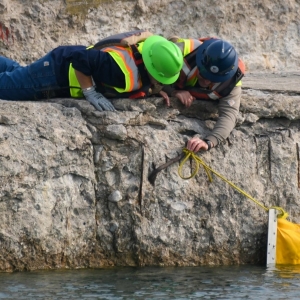Federal Water Tap, August 28: NOAA Updates High Tide Flood Forecast Tool
The Rundown
- The Department of Energy funds research for using oilfield wastewater to produce hydrogen.
- The EPA Office of the Inspector General says the agency needs clearer guidance on calculating cumulative impacts of pollution.
- When Congress returns next month, the farm bill will be top of the agenda.
- A bill in Congress would reform a farm conservation payments program.
- The White House posts comments from peer reviewers of its cost-benefit guidance for new regulations.
And lastly, NOAA introduces a monthly forecast for high tide floods and expects El Niño to increase the number of such floods in the next year.
“As relative sea levels continue to rise, high tide flooding is occurring more frequently. It no longer takes severe weather to cause disruptive flooding along the coasts. Over time, recurring high tide flooding can have major impacts on coastal communities by degrading infrastructure, property, and coastal ecosystems.” — Nicole LeBoeuf, assistant administrator for NOAA’s National Ocean Service
NOAA released its annual outlook for high tide floods. The agency also introduced a monthly forecast for high tide floods. It expects high tide floods to increase in 2024 as El Niño strengthens. The forecast projects that U.S. coastal communities will see an average of four to nine high tide flood days. The biggest effects will be in the Mid-Atlantic and West Coast, where the number of flood days should be even higher.
In context: Hidden Flood Risk for San Francisco Bay Area Communities Lurks Underground
By the Numbers
$10 Million: Department of Energy funding for two research projects that will use oilfield wastewater to produce hydrogen. Recipients are the University of Wyoming and Oceanit Laboratories, out of Honolulu. The grants are part of a larger funding package to boost hydrogen as an alternative energy source.
News Briefs
Farm Conservation Payments Bill
A bipartisan bill would reform a U.S. Department of Agriculture conservation program.
The program is EQIP, or the Environmental Quality Incentives Program, which pays farmers for conservation actions.
The bill, introduced in the House and Senate, intends to bring smaller farmers into the program and reduce the dominance of cattle and poultry. It would reduce the maximum size of grants and abolish the requirement that half of funds go to livestock operators.
Studies and Reports
Addressing ‘Cumulative Impacts’
The EPA’s internal watchdog says the agency must provide guidance on how to assess the cumulative burden of pollution across its program offices. These are the administrative divisions within the agency that address air, water, soil contamination, and other topics.
“If the Agency does not effectively work across programs to consider cumulative impacts, its ability to address disproportionate impacts to overburdened communities may be limited,” the Office of the Inspector General’s report states.
The agency agreed with the recommendations for clearer guidance and coordination.
Calculating Costs and Benefits
The White House is in the process of revising its guidance for how agencies add up the costs and benefits of new federal rules.
The Office of Management and Budget posted comments from the academic peer reviewers. Key questions center on the proper discount rate (How to compare the present and the future?), the scope of analysis (Whose benefits and costs count?), and the distribution of benefits (Do certain groups matter more than others?)
At least one reviewer said the guidance should also address how to review existing regulations.
On the Radar
Farm Bill…Coming Soon
When Congress returns from beach vacations a significant item of business awaits in September: the farm bill.
Renewed roughly every five years, the farm bill is the urban-rural unity package. It combines subsidies for commodity crop farmers with food aid for the poor. Total funding for the next version is likely to top $1 trillion over 10 years.
Environmental advocates hope that reforms to conservation and ecosystem protection measures will be included. That means more funding for practices that improve soil health, prevent erosion, store carbon, and limit polluted runoff.
Federal Water Tap is a weekly digest spotting trends in U.S. government water policy. To get more water news, follow Circle of Blue on Twitter and sign up for our newsletter.
Brett writes about agriculture, energy, infrastructure, and the politics and economics of water in the United States. He also writes the Federal Water Tap, Circle of Blue’s weekly digest of U.S. government water news. He is the winner of two Society of Environmental Journalists reporting awards, one of the top honors in American environmental journalism: first place for explanatory reporting for a series on septic system pollution in the United States(2016) and third place for beat reporting in a small market (2014). He received the Sierra Club’s Distinguished Service Award in 2018. Brett lives in Seattle, where he hikes the mountains and bakes pies. Contact Brett Walton






Leave a Reply
Want to join the discussion?Feel free to contribute!